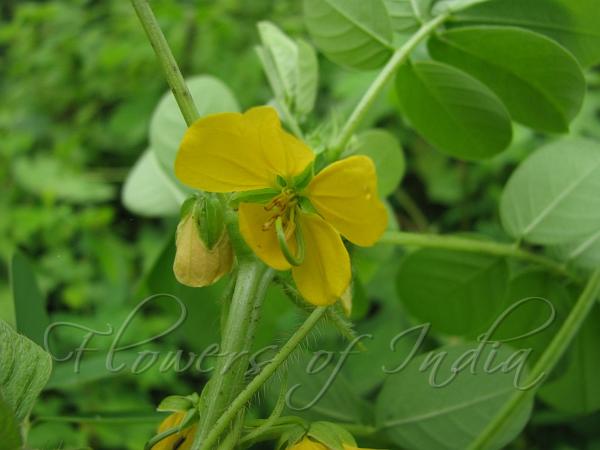|
| Sicklepod |
|

|

| File size | 156470 |
| Original date | |
| Resolution | 0 x 0 |
| Flash | Flash did not fire, auto |
| Focal length | 6.0mm |
| Exposure time | 1/500s |
| Aperture | 2.7 |
| Focus Distance | |
| Metering Mode | Multi-segment |
| Camera make | Canon |
| Camera model | Canon PowerShot S5 IS |
| Sensor type | OneChipColorArea |
|
|
|
|
Photo: |
Botanical name: Senna obtusifolia Family: Caesalpiniaceae (Gulmohar family)
Synonyms: Cassia obtusifolia, Cassia tora var. obtusifolia
Synonyms: Cassia obtusifolia, Cassia tora var. obtusifolia
Sicklepod is a short-lived undershrub growing to up
to 2.5 m tall, but usually less than 2 m in height. The lower stems
often sprawl along the ground in open areas. Plants produce numerous,
branched, sprawling stems that are 1.5-2 m long. These stems are
usually velvet-hairy when young, but become mostly hairless with age.
The compound leaves are borne on relatively short stalks 1.5-2.0 cm
long. They have two or three pairs of leaflets (1.7-6.5 cm long and 1-4
cm wide), with those further from the leaf stalk usually being larger.
The leaflets are egg-shaped in outline with the narrower end attached
to the stalk (obovate) and have rounded tips. There is a small
elongated gland 1-3 mm long located on the main leaf axis between the
lowest pair of leaflets (occasionally also between the second pair of
leaflets as well). The yellow flowers, 1.0-1.5 cm across, are borne on
stalks 7-28 mm long. These flowers usually occur in pairs in the leaf
forks and are mostly located near the tips of the branches. They have
five green sepals, 5.5-9.5 mm long, and five yellow or pale yellow
petals 8-15 mm long. Each flower also has seven fertile stamens with
anthers 3-5 mm long, that have a short narrow beak on one end. The
fruit is a slender, strongly curved downwards pod, 6-18 cm long and
2-6 mm wide, that is almost cylindrical in cross-section, sometimes
slightly flattened or four-angled. Sicklepod is a native to tropical
South America but has become widespread throughout the tropics and
subtropics.
| Identification credit: Gurcharan Singh | Photographed in Panvel, Maharashtra & near Dakpathar, Uttarakhand. |
• Is this flower misidentified? If yes,